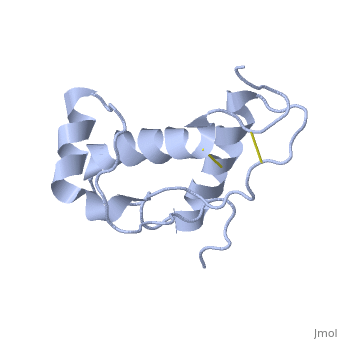1lg4
From Proteopedia
(Difference between revisions)
| (14 intermediate revisions not shown.) | |||
| Line 1: | Line 1: | ||
| - | [[Image:1lg4.jpg|left|200px]] | ||
| - | + | ==NMR structure of the human doppel protein fragment 24-152== | |
| - | + | <StructureSection load='1lg4' size='340' side='right'caption='[[1lg4]]' scene=''> | |
| - | + | == Structural highlights == | |
| - | + | <table><tr><td colspan='2'>[[1lg4]] is a 1 chain structure with sequence from [https://en.wikipedia.org/wiki/Homo_sapiens Homo sapiens]. Full experimental information is available from [http://oca.weizmann.ac.il/oca-bin/ocashort?id=1LG4 OCA]. For a <b>guided tour on the structure components</b> use [https://proteopedia.org/fgij/fg.htm?mol=1LG4 FirstGlance]. <br> | |
| - | + | </td></tr><tr id='method'><td class="sblockLbl"><b>[[Empirical_models|Method:]]</b></td><td class="sblockDat" id="methodDat">Solution NMR</td></tr> | |
| - | + | <tr id='resources'><td class="sblockLbl"><b>Resources:</b></td><td class="sblockDat"><span class='plainlinks'>[https://proteopedia.org/fgij/fg.htm?mol=1lg4 FirstGlance], [http://oca.weizmann.ac.il/oca-bin/ocaids?id=1lg4 OCA], [https://pdbe.org/1lg4 PDBe], [https://www.rcsb.org/pdb/explore.do?structureId=1lg4 RCSB], [https://www.ebi.ac.uk/pdbsum/1lg4 PDBsum], [https://prosat.h-its.org/prosat/prosatexe?pdbcode=1lg4 ProSAT]</span></td></tr> | |
| - | + | </table> | |
| - | + | == Function == | |
| - | + | [https://www.uniprot.org/uniprot/PRND_HUMAN PRND_HUMAN] | |
| - | + | == Evolutionary Conservation == | |
| - | + | [[Image:Consurf_key_small.gif|200px|right]] | |
| - | == | + | Check<jmol> |
| - | + | <jmolCheckbox> | |
| - | + | <scriptWhenChecked>; select protein; define ~consurf_to_do selected; consurf_initial_scene = true; script "/wiki/ConSurf/lg/1lg4_consurf.spt"</scriptWhenChecked> | |
| - | == | + | <scriptWhenUnchecked>script /wiki/extensions/Proteopedia/spt/initialview01.spt</scriptWhenUnchecked> |
| - | + | <text>to colour the structure by Evolutionary Conservation</text> | |
| - | + | </jmolCheckbox> | |
| - | == | + | </jmol>, as determined by [http://consurfdb.tau.ac.il/ ConSurfDB]. You may read the [[Conservation%2C_Evolutionary|explanation]] of the method and the full data available from [http://bental.tau.ac.il/new_ConSurfDB/main_output.php?pdb_ID=1lg4 ConSurf]. |
| - | NMR | + | <div style="clear:both"></div> |
| + | __TOC__ | ||
| + | </StructureSection> | ||
[[Category: Homo sapiens]] | [[Category: Homo sapiens]] | ||
| - | [[Category: | + | [[Category: Large Structures]] |
| - | [[Category: Guntert | + | [[Category: Guntert P]] |
| - | [[Category: Luhrs | + | [[Category: Luhrs T]] |
| - | [[Category: Riek | + | [[Category: Riek R]] |
| - | [[Category: Wuthrich | + | [[Category: Wuthrich K]] |
| - | + | ||
| - | + | ||
| - | + | ||
| - | + | ||
| - | + | ||
| - | + | ||
Current revision
NMR structure of the human doppel protein fragment 24-152
| |||||||||||


